
I’ve been running a self-publishing business for over ten years now, and it’s taught me a thing or two about not scaling.
First of all, if you never scale, you won’t lose money in any significant way. It’s pretty great. I don’t have warehouses full of goods I’m unable to sell. Creditors aren’t blowing up my phone. It’s just a slow trickle to keep it alive, monthly hits of banking fees and a phone bill, plus what it takes to run my servers. It’s under a hundred dollars a month, although there are some yearly business admin fees and of course the PO box rental and also taxes.
You can save a lot of money, too. I’ve released 3 books, one game (multiple times), productivity software, comic collections & multiple blogs, and NOT ONCE have I had a release party. Think of how much I’ve saved on venue rentals, not to mention the cost of sparkling wine.
Another great reason not to scale is that your business won’t take over your life. You see some startup people with the heavy eyelids and the need to “blow off steam” with substance abuse. Don’t scale, and these won’t be a problem for you. Just go home after work and sleep! Sleep is so good.
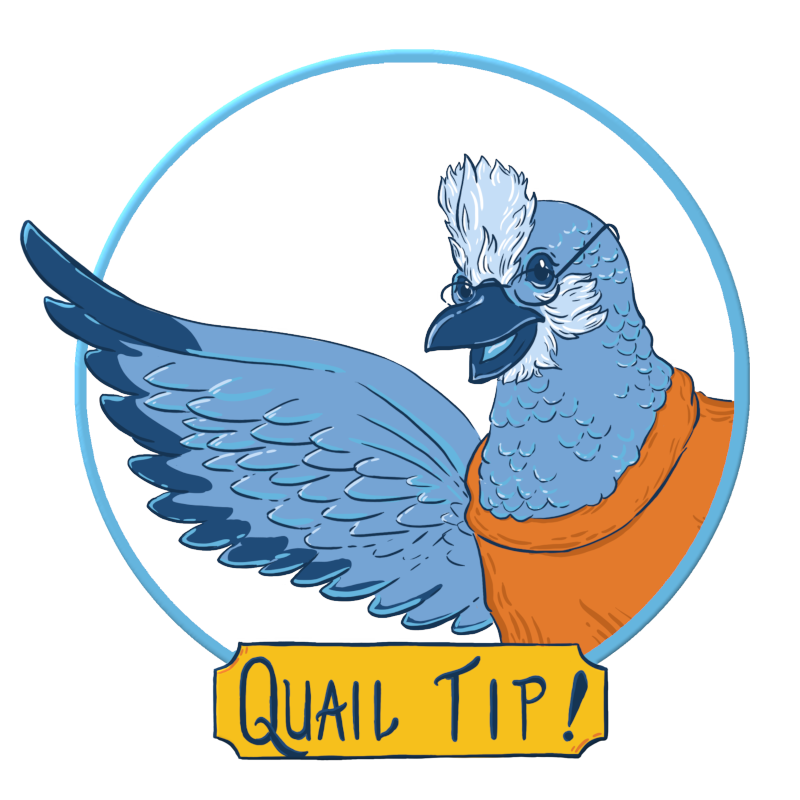
Bring a book if you're tabling at a convention or trade show!
An often underrated bonus to not scaling is that, if you’re selling your products at conventions, trade shows, and other public exhibitions, people aren’t mobbing your table. God! You see some of those tables. It’s like, come on. Give the entrepreneur some space. If you keep your business not-scaled, you’ll get some well-deserved time to be by yourself. And people do still come by to look.
I must say, I’ve gotten pretty good at not scaling. But having mastered that particular area of the business world, I think I’m ready for a new challenge. I’m ready to scale this business, and, if you have one of your own, you can follow along at home.
Our first step is to make a pre-scale checklist. NEXT →
By now I’ve decided to scale my startup rather than the alternative of not-scaling, but before you try it on your own business, ask yourself: “Do I have the raw material I need to scale?” Let me clarify what I mean by “raw material,” because it isn’t initially clear in the question I want you to ask yourself, out loud.
It seems to me, as someone imminently ready to scale a business, that one needs to have a product in place, or a service, that is currently able to be sold. If you’ve only got vaporware, and you don’t plan on actually delivering, scaling up your business may bilk investors out of money, which is illegal. Be careful — make sure your product exists before officially attempting a scale. You could be jailed.
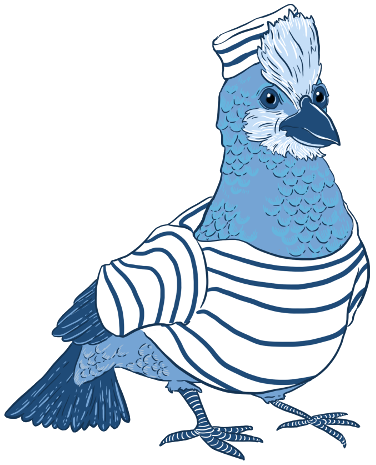
A jailed quail.
Your product is a seed. I use this botanical metaphor as it’s handy for visualizing the growth you want to mimic in the near future. Think of this seed, and envision the plant you could grow it to be.
Do you see it? Right now? What are you imagining? Is it thick? Does it have flowers? Is it a TREE? Could it survive a few chops with an axe? I should say right now: if your plant doesn’t have built-in defense mechanisms against attackers, you’re not thinking about this like an entrepreneur who’s poised to succeed. Maybe you should re-evaluate your personality.
Speaking of seeds, do you have seed funding? This whole “scaling” thing is going to be a lot easier if you do. Anyway. You need at least some money, and a willingness to spend it. Practice now by buying yourself a new suit.
In summation, the pre-scale checklist is as follows:
If you have a product, a clear vision of its future, a bit of money to throw around, the mindset to destroy anyone who positions themselves against you, a suit, and an artist you can hire to draw your animal mascot in various outfits, you’re ready to scale. We start immediately. NEXT →
Alright — I’ve completed the Pre-Scale Checklist, so I’m ready to scale my publishing startup. I’ve got a number of financially dormant products I can potentially growth-hack into the profitsphere:
An illustrated adventure revolving around the ancient, extremely popular board game of Go. Digital copies are available behind a paywall – a classic business strategy, but one that requires me to keep writing books if I want to scale it.
A sci-fi horror comedy crime novel about the rise of AI in future Nova Scotia, and what can happen when there are also ghosts involved. As packed with jokes as it is prophetic, this book's success can only increase. Full disclosure: this is the one that I most want to succeed. Please buy Ghostcrime.
Ghostcrime also has a software tie-in. Do you need an inexpensive CRM solution? ghostCRM can keep track of your contacts and reminds you about your various obligations. It’s free, though it does shill Ghostcrime at the first opportunity.
ghostCRM will play an important role in scaling, at the very least by saving me thousands of dollars in SalesForce licenses.
A massive interactive story and possibly the most comprehensive text-based diamond-finding simulator available, at over 85,000 words of fast-paced diamond-finding.
Right now it's free, and everyone loves diamonds, so it's definitely, definitely scalable.
A blog about my experiences living with an adorable badger. There’s no way for readers to interact with this blog or put money into it, but so far it’s hooked a few readers who like badgers. Scaling this one may be a challenge, but luckily, I think it can be done.
I will start by writing business algorithms. NEXT →
I’m about to scale up my small comedy startup into a highly-profitable, automated laughter machine, but before I begin, I want to set down some algorithms for the upcoming scale.
Please note that I made these highly PowerPoint-able, in case anyone wants to throw them into a PowerPoint for any reason:
I’m already pretty deep into a blog post, so I might as well break these down.
What’s the first question you ask your startup friend? “How’s business?”
You should already know. Why don't you?
It may seem like I’m berating you here, but rather it’s the entrepreneur’s responsibility to make that information public. In practice, this means implementing public real-time dashboards, putting out newsletters or blog posts, and open-sourcing code.
If you had to ask your question, your startup friend obviously hasn't been doing these things – and by wasting their time, you harmed their business! I am berating you now.
It's common sense if you've ever been to an orchard, but even so, it needs codifying as an algorithm. Two features to implement? Do the easier one first & start seeing the benefits sooner.
It also may help, depending on the kind of person you are, to literally think of each task as a piece of fruit. Which is juicier? This makes it very satisfying to complete business tasks. If you have seed or venture capital lying around, use some to purchase a bowl of high-quality wax fruit to keep in the office as a constant reminder.
I’ve got physical books taking up space in the utility closet, but it’s cheaper and easier to distribute them as computer files. When given the option of which channel to support, always go digital first.
Those physical products are just appreciating in value, anyway – they'll become “rare classics” that can be sold for multiples of their current value in secondary markets.
I might make one sale per day, but if I want to scale that up to 100, it’s not going to happen in one fell swoop. Smaller, more frequent multipliers will give steadier growth, are easier to implement, and they add up.
If a sleazy growth consultant comes to you claiming they can give you a 100x scale overnight, take them out for drinks and see what else they lie about.
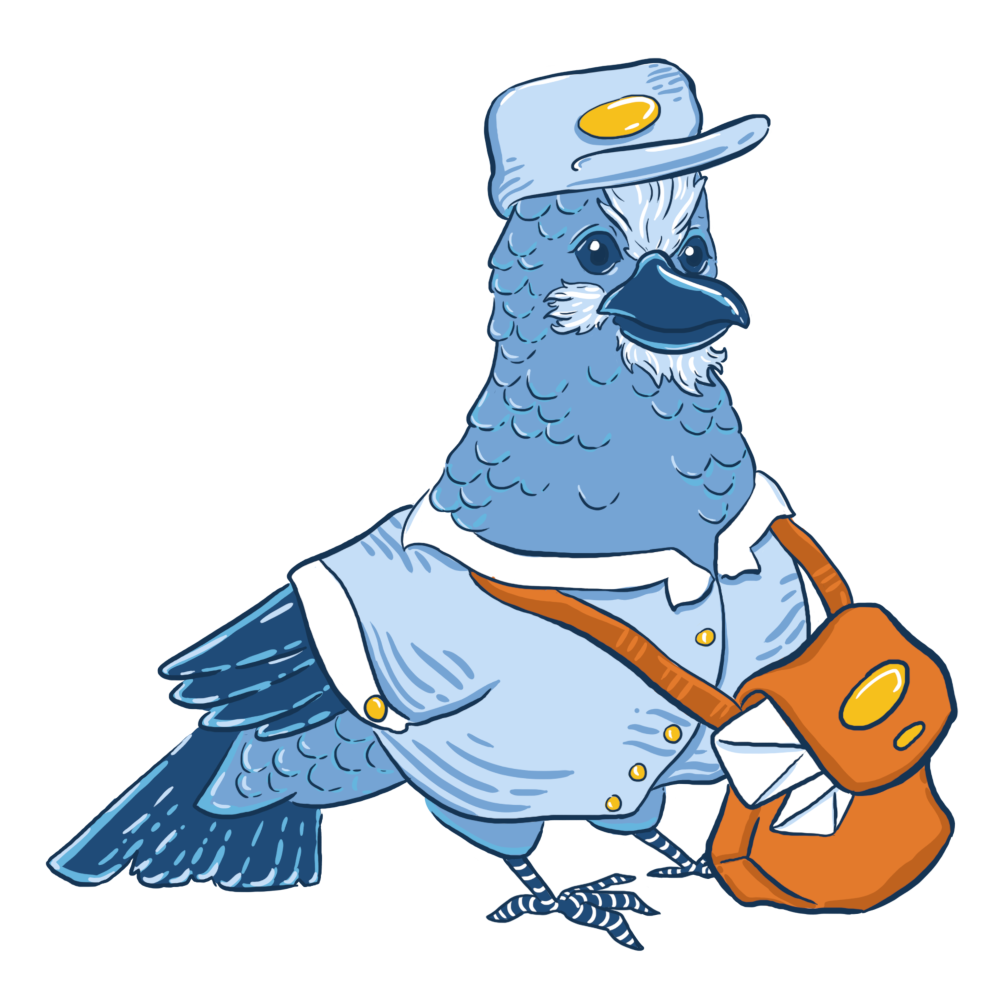
If you have a system for automatically sending email to your users when something happens on your site, ask yourself when implementing a new feature... what can the auto-mailer do here? Can it remind your users that you exist? Can it email you about what to focus on next? Can it harrass you about your metrics? So many jobs for the auto-mailer.
If you don’t have one, get that consultant back and see if they’ll build one for you – if you can handle having that kind of person in your life.
If you're putting out free content like a blog or podcast, it may start to feel draining to put in work when there's never a paycheck at the end.
But if you're an entrepreneur, you probably have lots of products lying around. Is there some convoluted way to tie your blog post into one of those? That way, your relatively low-effort content still feeds the insatiable profit machine. Remember: If you're vyin' for buy-in, do a tie-in.
Now that I’ve got some basic algorithms in place, I can start to scale up my business. I’m going to start digital-first — adding a multiplier to my eBook store. NEXT →
I’ve got a lot of growth to hack in my startup, but luckily, there’s some low-hanging fruit in my e-book store that I can harvest. The profit margin is highest on digital products — and I don’t have to do any extra work when one is purchased — so it only makes sense to scale up these numbers first.
If you're working with software, maybe you've encountered this problem: some developer got all ambitious with your webstore back in 2016 and now it's a fragile, complicated spiderweb of code. Sure, it supports Gift Packs, Discounts, Price Combos, and Paperbacks, but it's a nightmare to modify and it can't be turned off.

This next part involves the computer.
While revenue can only increase by ripping out the code that gives away free books, the real problem is the paperbacks. People are buying them one at a time, for themselves. Talk about a 1x multiplier!
And the fleeting joy of making a sale is quickly replaced by drudgery – I'll sigh, make a label, do an envelope, pack it up with some freebies, and walk to the post office in sad solitude. It’s nearby, but the process is painful for a single sale, especially if it's raining that day.
There are ways to make the fulfillment process less terrible: a dedicated label printer, a loyal assistant, or even an umbrella. But it’s still work, which is annoying, considering I already did work by writing the books.
The obvious solution is to sell in bulk. If we're shipping ten books at once, it's effectively ten times less work, per book. Libraries and bookstores need multiple copies, and if you convince an investment bank of your worth, they'll be ordering by the thousands.
But bulk selling is a significant effort. It'll require:
a new retailer portal to accommodate large purchases
logistics for pickup and delivery of books
connections at libraries, bookstore chains, and investment banks
a warehouse of some kind
This is way too much work, and with warehouses, there's the additional problem of rats. Plus, it’s too focused on physical distribution, where the returns are far higher on the digital side. Therefore, the ScaleQuail solution is to stop selling physical books entirely. And all that awful code can be deleted!
Now we can focus on digital distribution. But the principles of bulk still apply: selling ten books in one transaction is preferable to just one. As such, we'll chase larger sales by bundling together digital goods in the form of a loyalty program. NEXT →
I just got done enhancing my eBook store by ripping out some terrible code, but there's one more product to add to the offerings: the Lifetime Membership.
I tried a membership model years ago with the Precious Metals Reserve, but its premise never caught on. The concept was, for ~$10, I would snail-mail you a hand-drawn comic, but there was a possibility you’d receive a real silver coin instead.

Now THIS was a solid idea, though maybe a bit underpriced.
I’m still surprised it wasn’t successful. But now, with more products at my disposal, I can command a higher price even without all the silver. The concept of the new membership plan is as follows:
For $100, you get access to all e-books produced by the business, in perpetuity.
Business critics will point out that it’s not Monthly Recurring Revenue, or that it cashes out a customer’s lifetime value immediately. While collecting semi-reliable payments every month could provide circling VC firms with familiar metrics, they'll still gut the firm and sell it for scrap as soon as the market tanks. Rather, committed core supporters who've paid a premium will support a business into the future no matter what, due to the sunk cost fallacy.
Other, different detractors might do the math and say that $100 is overcharging for only a few e-books. But this is a lifetime membership. Unless you think I (or you) is to die anytime soon – and if you do, please let me know! – you’re getting a deal lasting many years. Plus, you’ll be part of the inner circle, and the fact that I’ve put a price on that shouldn’t negate the fact that you can’t put a price on that.
The alternative is the Patreon model — a small payment every month in exchange for a trickle of output. Do you want a trickle? If so, say it out loud, right now: “Yes, I want only a trickle.”
Your silence is all the encouragement I need, so I’m going to go ahead and implement a Lifetime Membership. And I'll make a Monthly option too, just so everyone shuts up. It’s not like I have anything else to do tonight.
Now I can push this on social media – however, my inability to self-promote is the biggest barrier to scaling this business. Luckily, it’s purely psychological, so next I’m going to destroy whatever it is about my personality that’s holding me back. NEXT →
Last time, I attempted to maximize the value of my existing products by introducing a lifetime membership, but so far I haven’t seen an uptick in revenue.
Could it be because I haven’t told anyone about it on social media? Or, for that matter, about the existence of ScaleQuail?
It may be my biggest failing as an entrepreneur that I only post about my new stuff once or twice before moving onto the next thing. But today I’m going to explore why, and either find convenient psychological workarounds, or consciously eradicate those aspects of my personality. (If you’ve never had to do that, you may not be ready for the world of business.)
One of the reasons I don't make excessive noise about my work is because I’m not confident it’s good. Obviously, that’s ridiculous! Badger blog is good. But the silence of my notifications speaks volumes. And because I produced the work myself, feelings can cut to the bone.
Strategic de-personalization is a technique I’ve applied before, but I can’t recommend it. Blocking out memories and emotions just to sell products online is a slippery slope. We’ve all known business leaders who’ve chosen this route, and their cold eyes stay with us long after the meeting is over.
A healthier workaround is to have an automated service do advertising without my knowledge. With a pile of content in the hopper, and a system that publishes at random times throughout the day, I can get my marketing done without worrying about it — or, at least, pushing it into the background with climate change and armies of robot assassins.
Of course there’s software that does this. HootSuite is bird-driven, like ScaleQuail, so it’s the natural choice. With a 30-day trial, I’m off and running. Or, maybe I should say, flying.
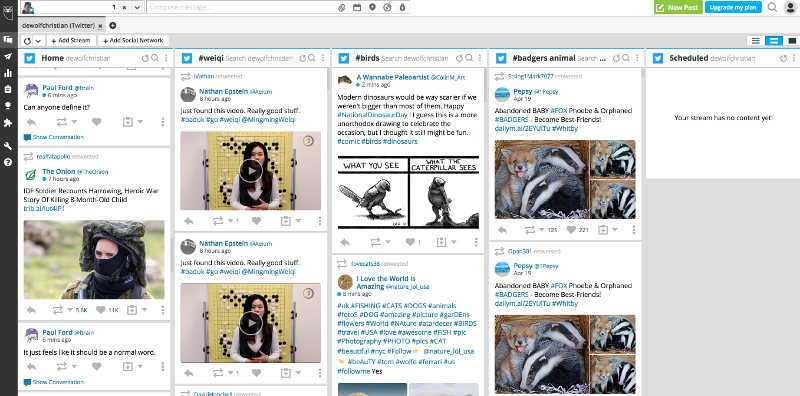
Everything that’s relevant to me in one place.
Alright... wow. Is this what it feels like to be an Influencer? Aw, it tells me how to put tracking links into my posts. And that dashboard. I can target people in specific groups by watching hashtags. This is great. I hope it filters out reaction GIFs. (UPDATE: it does not)
Now that I can see Twitter from the Content Producer point-of-view, I have all the tools I need to do a professional social media blitz. I may not even need to de-personalize as I drive up my follower count with coldly measured, consumable content.
There’s really no excuse for me not to do Twitter campaigns now — unless, of course, I forget to do one.
Forget might not be the exact word, but for days at a time I'll dive into some new project, or have to catch up on six months of backlogged accounting. It’s happened before, and not only for Twitter. Hell, I keep forgetting about my PO box, and I almost never think about my Goodreads account.
This is why I need a general business dashboard, something to keep every active tendril top-of-mind. I would rather do anything but advertise, and there’s plenty else to keep me occupied, but if I’ve got a visualization of all possible business activities, I can see what I’m neglecting, and spread myself out more evenly.

My business tasks generally fall into these categories:
To balance these four needs, I’ll create a QAWP Wheel using an old LP:
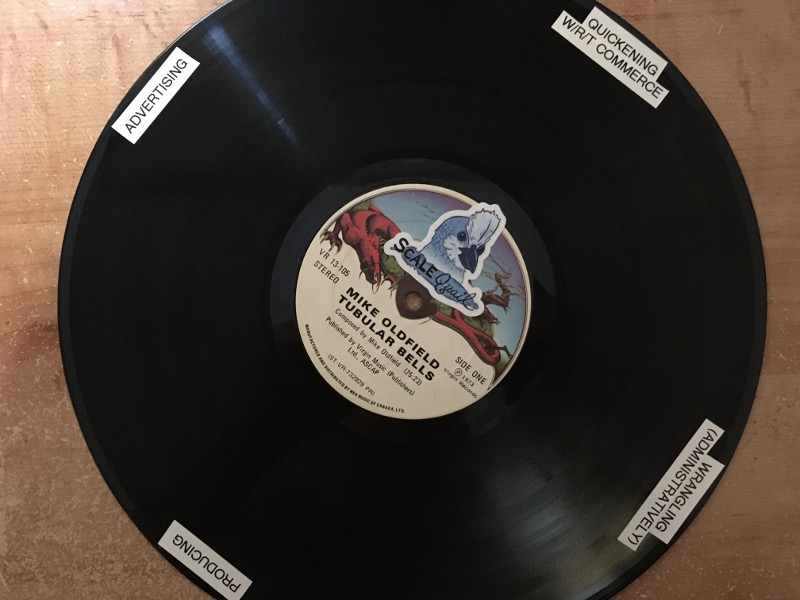
The basic form of a QAWP Wheel. Apologies to Tubular Bells.
From here, I use a labeler to apply my tasks in the appropriate areas, then pin the wheel in my work area where it can freely spin.

My QAWP Wheel in action. It could also be laid flat if you like the DJ aesthetic.
Now, when I’m in advertising mode, I can fill my Scheduled Tweets queue full of great content and then safely forget about it for a few days. And maybe I’ll finally connect with someone on Goodreads (but still, probably not).
But it’s important that I do communicate with customers directly instead of just passively blasting out words. This is one of those tasks that I won’t voluntarily do, especially if there are other activities available, but luckily, my trusty auto-mailer is up to the task.
Ideally, if someone downloads a book, I’d send them an email to ask what they thought, and ask if they’d leave a Goodreads review. I have all the data I need, so if the user has consented to receive emails, I can set up a one-button auto-sender for eligible users in my rickety admin area:

Crab User got a lot of emails during testing.
I could automate this even more, but I like the control, and I want to be able to address the user by first name in the email only when I know it’s appropriate. A machine may be performing my arduous social tasks, but it still has to feel personal.
One more thing is necessary to complete the illusion:
You can really anger some digital marketers by doing this.
Turn off the tracking! Unless you want every link in the email to come out as a nasty mess of parameters and ruin the personal façade we’re trying to create here. It’s subtle, but people notice.

I AM NOT A ROBOT. PLEASE LEAVE A REVIEW.
Ah, but then I won’t be able to track my opens and click-throughs. You think I care who opens what emails? Oh, I’m supposed to A/B test the subject lines? Guess I should have A/B tested every line in my books, too. Make sure I wrote the right things.
With personal, psychologically manageable ways to push out content, I should hopefully see that “bump” in revenue I’ve heard so many founders talk about. But if I want to maximize it, I’ve got one more marketing scale to put in place that’ll make my efforts at least five times more effective — fusing my website into a revenue monolith. NEXT →
Now that I’ve automated some marketing and patched up a few psychological flaws, I’m almost ready to push products to my network. But there’s one more scale I have to implement before I put my life savings into billboard space.
Before, when contemplating a scale to my physical book distribution system, I estimated that shipping ten books at once was ten times less work, per book, than shipping one by one. Today I’m going to use an inverse of that theory to scale my marketing efforts.
Right now, there are at least ten destinations within the website, each with separate audiences. The #SickGoTakedowns hashtag used to introduce the Snapback series to Go players might not be effective on a potential Ghostcrime reader, who may instead be pulled in with neon ghost/robot art. But if it's easier to navigate around the site, they'll explore and discover these other purchasing opportunities.
If you have a similar portfolio of disconnected comedy products, this next part will definitely be applicable.
The trick is to unite all of your unrelated products into one monstrous platform. Each book, blog, or game becomes a module of a much larger machine, and the marketing of one has the effect of marketing the whole. Now we must oil the machine, which sounds disgusting, but it’s necessary.
First, I’m going to analyze my blogs to make sure it’s easy to jump from post to post. ScaleQuail has a linear format, and prominent links page forward and backward, so it’s fine for now. The badger blog, however, needs some love. It’s a venerable story of human/animal relations, but by default it displays latest posts first. At this stage, I need to accommodate new readers who want to read the whole thing from the beginning.
This is as easy as improvements get, just a link to the posts sorted in reverse:
Next, I’ll look at the Mirth Turtle blog, which hosts a collection of older comedy essays, game reviews, and clickbait listicles. The range of topics is broad, so a custom recommendation engine is required here. It’s a simple build, choosing two posts related by Category or Tag, then a random third post for variety. With some new thumbnails to denote category, it’s done:
Getting readers deeper into the blogs is one thing, but to go from free short-form comedy to buying my entire creative output, they need to hop around. I was originally thinking a kind of an internal ad network, but everyone hates ads! That’s why you all use ad-blockers? (you should be using an ad-blocker)
I opted for a less obtrusive design — a bar along the top that lets you know you’re in a sub-area, with easy navigate home and also space to push the lifetime membership. Please buy a lifetime membership.

How innovative, you’re probably saying. A bar. Yeah, how about you just go to hell, you piece of shit.
Now that my products are woven together into a multi-faceted revenue-generation monolith, it’s time to drive some serious traffic. In true ScaleQuail fashion, I’m going to accomplish this by orchestrating a marketing cyclone.
The difference between a cyclone of marketing and the regular kind is chaos. A traditional marketing campaign has focus. A marketing cyclone hits the populace with so many different ideas, they’ll wonder with each new ad they see whether it’s also secretly one of yours. A marketing cyclone is loud, unpredictable, and it’ll foster in the customer a paranoia that it’ll strike again at any moment.
A revenue monolith is perfectly suited to this kind of campaign, but if I’ve learned anything from the internet, it's that the Hootsuite hopper doesn’t fill itself. It’s hungry for content, like the public, and a well-planned marketing cyclone demands high-quality debris. NEXT →
After completing the essential step of fusing my content into a single monolith to better coalesce profits, I also committed to blasting out a marketing cyclone. However, I’m going to need sharable content of the highest quality.
We’ll start with a bit of melon-driven marketing. I believe there’s a universal love for large, juicy fruit, but we’ve all seen arguments arise over which type of melon is supreme. To capitalize off this conflict, I’ll build a standalone melon selector:
The user is given a choice of melon, generic enough to project their ideal melon onto, and passes through to a melon takeover of the main website:
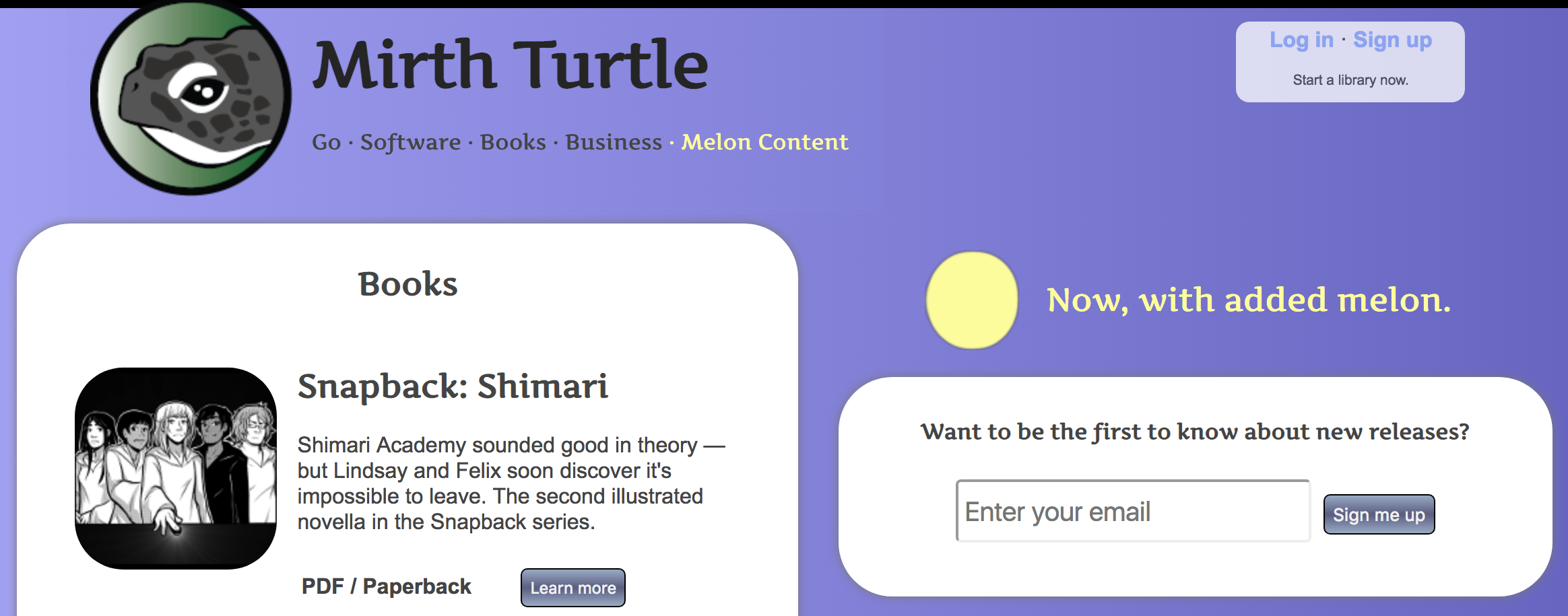
See the site through a melon lens.
It’s the most basic form of content I want to inject into the cyclone — seemingly unrelated to the flagship products, but funneling traffic to them in just a few non-threatening clicks.
I’ve tried this strategy before, most notably with ClamBlog, a blog about clams written by “other people” where I occasionally do an interview about a non-clam-related new product.
All in all, it only ever promoted one thing: a misguided interactive fiction engine I’d built. While that captured no one’s imagination, ClamBlog was a solid marketing idea, suffering, I think, from its inherently disgusting subject matter.
Still, I was right about one thing — there’s demand for interactive fiction. Years ago, I wrote a book about a real estate development company run by cats, and although it arguably sucked, it’s ripe for a playable sequel.
Promising I’d treat myself to a fine bottle of cognac once completed, it came together pretty quickly, and a bit of stuffed animal photography later, it’s ready to go:

As Calico, you go on office adventures, picking up office supplies that help you solve puzzles later.
This should satisfy the IF crowd, and maybe some furries too, but there’s a new generation of gamers who prefer “idle” games, which run in the background while they go about their other business. Using vivid memories of that time I miserably failed at being a day trader, I’ll build a bare-bones stock market simulation for those craving intermittent financial excitement:
This doesn’t make me any money directly, but it might be a good platform to sell thematically-related products. The marketing cyclone still needs more content, so obviously the course of action now is to produce a gold credit card for the tie-in.
Magnetically encoded with unique jokes, the Comedy Gold lustrecard is the financial instrument of laughter — if you can find a card reader that will actually tell you what’s on it.
Is this not a product that people want? It’s a meta joke about the inaccessability of our own money in a civilization in the stranglehold of corporate technology. Of course it’s a good product. Don’t tell me that I don’t understand capitalism.
I’m not going to sell these outright, but rather use them to shine up the Lifetime Membership package, and raise the price accordingly.
Now that the marketing cyclone is whirling with content, we’re almost ready to wreak revenue chaos on the first cohort of pre-customers. However, if we want to optimize our cyclone for maximum devastation, we have to make the debris much heavier.
Let’s start with The Calico Brief above. It’s already a hefty offering, but a completionist may be curious about paths they missed, and a hacker-fan may want to feed it into an AI for their own amusement. To satisfy these demands, I’ll release its full story code, 35,000 words of cat workplace adventure, on GitHub. Now that’s content marketing!
Next, let’s upgrade the melon selector. Although the data I’m collecting off the melon clicks could drive further business decisions, the MVP only has one feature, and although it’s iconic and mobile-friendly, a discerning customer expects more from their software experiences. As such, we’ll transform it into a full-blown kitchen management suite:
Now users will get a soothing inventory management system for their pantries and an easy way to plan shops. Oh, do you already have software that solves this problem? That’s right. You don’t. Your food just rots.
Finally, as a bonus for power users who have a Linux-based terminal in their kitchen, I’ll also release a command-line integration:
Finally: you can use the melon selector without having to haul out your mobile device while cooking.
Now that our content has some weight to it, our marketing cyclone can hit at peak effectiveness. But if we’re serious about operating a business that runs by itself, so that at some point we can go enjoy the outdoors, we’ll need more than just great content.
The final step is to plug our business into an Infinity Drive. NEXT →

Come back soon to see how the next plan hatched.